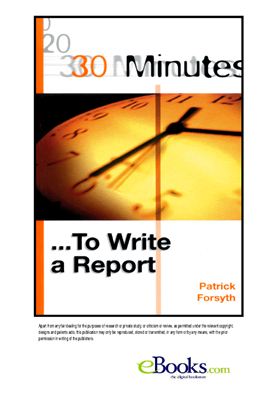Writing, especially business writing, often seems a real chore. And
reports are, by definition, among the longer forms of business
writing. But reports have an important role to play, so they have
to be written and written well. If your first feeling when a report
writing job drops on your desk is one of apprehension or even
dread, then this book is for you. It will help too, even if you
have written many
reports, but want to improve your writing skills just a little. Report writing might be called a career skill. In other words, there are many jobs where the ability to execute it well is a prerequisite for success and even for career progress. If you present a well-thought out document, people are more likely to want to read what you put in front of them, and to take notice of what it says. This is true of certain other skills, and, in common with them, writing a good report does not just happen; study – and
practice, of course – can make it much easier. The series is designed to achieve its aims promptly in a
minimal space. So, without further ado, we will get into the ‘how to’ of report writing.
Contents
The Opportunity (Prevailing standards; The worst case; Easily influenced: for good or ill;
Reader expectations; Specific requirements and rewards).
Preparation and drafting (The first question: why? ; Information is power; A systematic approach).
SHAPE AND STRUCTURE (The beginning; The middle; The end; Anything further? ).
THE POWER OF LANGUAGE (An appropriate and effective style; What readers expect; Readers’ dislikes; The writer’s approach; The use of language; Mistakes to avoid; Following the rule; Style).
THE RIGHT LOOK (The format of a report; The layout of the pages; The use of exhibits; The overall ‘packaging’ of a report; A final judgement).
Afterword
reports, but want to improve your writing skills just a little. Report writing might be called a career skill. In other words, there are many jobs where the ability to execute it well is a prerequisite for success and even for career progress. If you present a well-thought out document, people are more likely to want to read what you put in front of them, and to take notice of what it says. This is true of certain other skills, and, in common with them, writing a good report does not just happen; study – and
practice, of course – can make it much easier. The series is designed to achieve its aims promptly in a
minimal space. So, without further ado, we will get into the ‘how to’ of report writing.
Contents
The Opportunity (Prevailing standards; The worst case; Easily influenced: for good or ill;
Reader expectations; Specific requirements and rewards).
Preparation and drafting (The first question: why? ; Information is power; A systematic approach).
SHAPE AND STRUCTURE (The beginning; The middle; The end; Anything further? ).
THE POWER OF LANGUAGE (An appropriate and effective style; What readers expect; Readers’ dislikes; The writer’s approach; The use of language; Mistakes to avoid; Following the rule; Style).
THE RIGHT LOOK (The format of a report; The layout of the pages; The use of exhibits; The overall ‘packaging’ of a report; A final judgement).
Afterword

